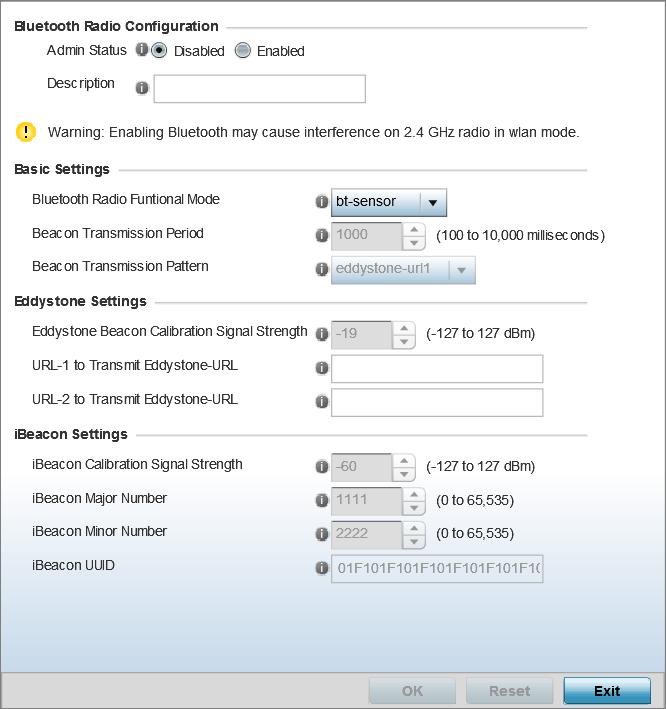The AP7602, AP7612, AP7632, AP7662, AP8432 and AP8533 model access points utilize a built in Bluetooth chip for specific Bluetooth functional behaviors in a WiNG managed network.
AP-8432 and AP-8533 models support both Bluetooth classic and Bluetooth low energy technology.
These platforms can use their Bluetooth classic enabled radio to sense other Bluetooth enabled devices and report device data (MAC address, RSSI and device calls) to an ADSP server for intrusion detection. If the device presence varies in an unexpected manner, ADSP can raise an alarm.
BLE enabled access points support Bluetooth beaconing to emit either iBeacon or Eddystone- URL beacons. The access point‘s Bluetooth radio sends non-connectable, undirected low-energy (LE) advertisement packets on a periodic basis. These advertisement packets are short, and they are sent on Bluetooth advertising channels that conform to already-established iBeacon and Eddystone-URL standards. Portions of the advertising packet are still customizable, however.

Note
The WiNG 7.1 release does not provide Bluetooth support on AP505i and AP510i model access points. This feature will be supported in future releases.To define a Bluetooth radio interface configuration:

| Admin Status | Enable or Disable Bluetooth support
capabilities for the access point radio
transmissions. The default value is disabled. |
| Description | Define a 64 character maximum description for the access point‘s Bluetooth radio to differentiate this radio interface from other Bluetooth supported radio‘s that might be members of the same RF Domain. |
| Bluetooth Radio Functional Mode |
Set the access
point‘s Bluetooth radio functional mode to either
bt-sensor, le-beacon,
le-tracking or le-sensor.
|
| Beacon Transmission Period |
Set the Bluetooth radio‘s beacon transmission period from 100 - 10,000 milliseconds. As the defined period increases, so does the CPU processing time and the number packets incrementally transmitted (typically one per minute). The default setting is 1,000 milliseconds. |
| Beacon Transmission Pattern | When the Bluetooth radio‘s mode is
set to le-beacon, use the enabled
drop-down menu to set the beacon‘s
emitted transmission pattern to eddystone_url1, eddystone_url2, or ibeacon. An eddystone-URL frame broadcasts a URL using a compressed encoding scheme to better fit within a limited advertisement packet. Once decoded, the URL can be used by a client for internet access. If an eddystone-URL beacon broadcasts https:anysite, then clients receiving the packet can access that URL. iBeacon was created by Apple for use in iOS devices (beginning with iOS version 7.0). Apple has made three data fields available to iOS applications: a UUID for device identification, a Major value for device class, and a Minor value for more refined information like product category. |
| Eddystone Beacon Calibration Signal Strength | Set the Eddystone Beacon measured calibration signal strength, from -127 dBm to 127 dBm, at 0 meters. Mobile devices can approximate their distance to beacons based on received signal strength. However, distance readings can fluctuate since they depend on several external factors. The closer you are to a beacon, the more accurate the reported distance. This setting is the projected calibration signal strength at 0 meters. The default setting is -19 dBm. |
| URL-1 to Transmit Eddystone-URL |
Enter a 64-character maximum Eddystone-URL1. The URL must be 18 characters or less once auto-encoding is applied. URL encoding is used when placing text in a query string to avoid confusion with the URL itself. It is typically used when a browser sends data to a web server. |
| URL-2 to Transmit Eddystone-URL |
Enter a 64-character maximum Eddystone-URL2. The URL must be 18 characters or less once auto-encoding is applied. URL encoding is used when placing text in a query string to avoid confusion with the URL itself. It is typically used when a browser sends data to a web server. |
| Beacon Calibration Signal Strength | Set the iBeacon measured calibration signal strength, from -127 dBm to 127 dBm, at 1 meter. Mobile devices can approximate their distance to beacons based on received signal strength. However, distance readings can fluctuate since they depend on several external factors. The closer you are to a beacon, the more accurate the reported distance. This setting is the projected calibration signal strength at 1 meter. The default setting is -60 dBm. |
| iBeacon Major Number | Set the iBeacon major value from 0 - 65, 535. Major values identify and distinguish groups. For example, each beacon on a specific floor in a building could be assigned a unique major value. The default value is 1,111. |
| iBeacon Minor Number | Set the iBeacon minor value from 0 - 65, 535. Minor values identify and distinguish individual beacons. Minor values help identify individual beacons within a group of beacons assigned a major value. The default setting is 2,222. |
| iBeacon UUID |
Define a 32 hex character maximum Universally Unique IDentifier (UUID). The UUID classification contains 32 hexadecimal digits, split into 5 groups, separated by dashes – for example, f2468da6-5fa8-2e84-1134- bc5b71e0893e. The UUID distinguishes iBeacons in the network from all other beacons in networks outside of your direct administration. |